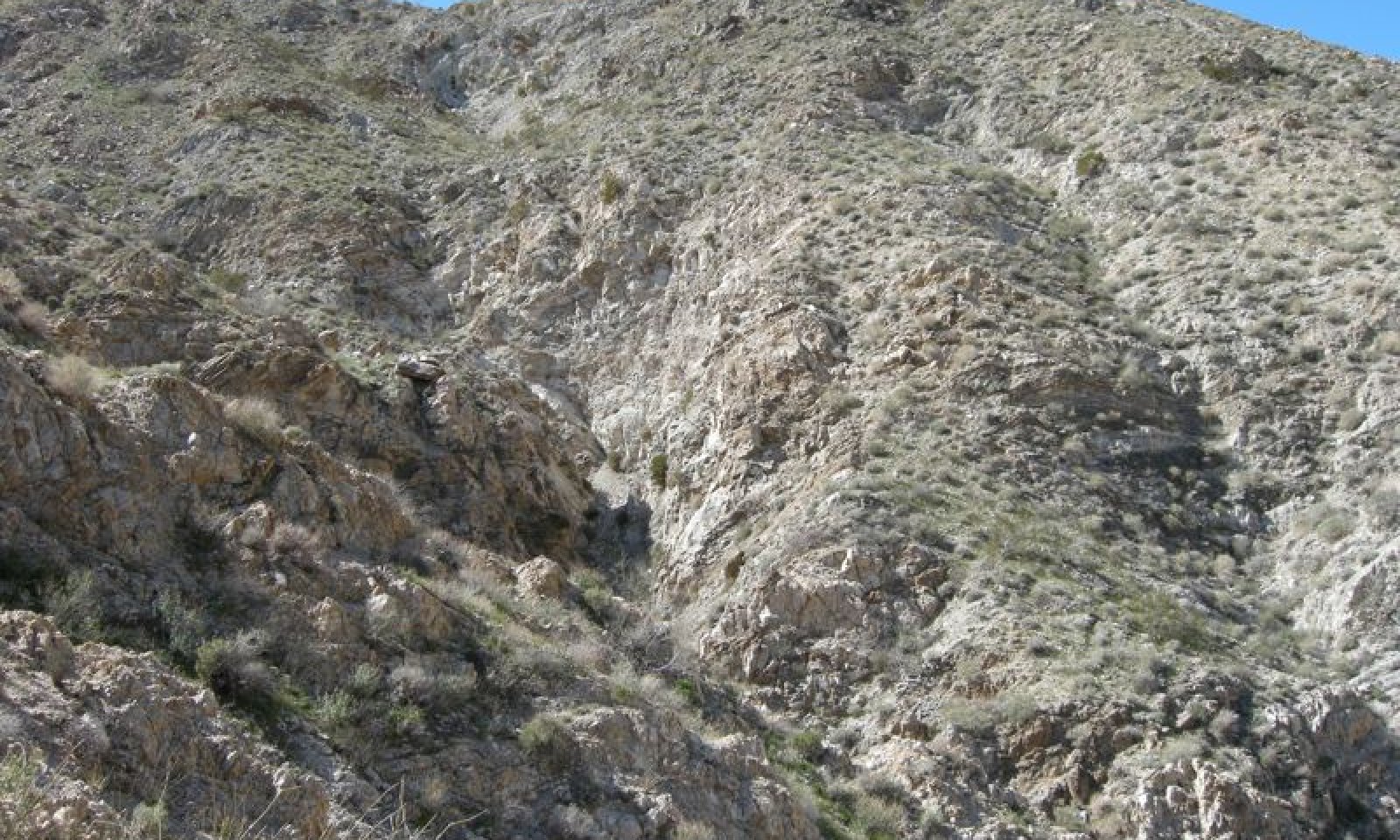

Natural Resources
Conservation Service
Ecological site R030XD040CA
Hyperthermic Steep North Slopes
Last updated: 10/21/2024
Accessed: 12/21/2025
General information
Provisional. A provisional ecological site description has undergone quality control and quality assurance review. It contains a working state and transition model and enough information to identify the ecological site.

Figure 1. Mapped extent
Areas shown in blue indicate the maximum mapped extent of this ecological site. Other ecological sites likely occur within the highlighted areas. It is also possible for this ecological site to occur outside of highlighted areas if detailed soil survey has not been completed or recently updated.
MLRA notes
Major Land Resource Area (MLRA): 030X–Mojave Basin and Range
MLRA Description:
Major Land Resource Area (MLRA) 30, Mojave Desert, is found in southern California, southern Nevada, the extreme southwest corner of Utah and northwestern Arizona within the Basin and Range Province of the Intermontane Plateaus. The climate of the area is hot (primarily hyperthermic and thermic; however at higher elevations, generally above 5000 feet, mesic, cryic and frigid) and dry (aridic). Elevations range from below sea level to over 12,000 feet in the higher mountain areas found within the MLRA. Due to the extreme elevational range found within this MLRA, Land Resource Units (LRUs) were designated to group the MLRA into similar land units.
LRU Description:
This Land Resource Unit (designated by ‘XD’) is found on the eastern side of California. Elevations range from 400 to 2200 feet on average, but may be found up to 3600 feet on southern exposures. Precipitation ranges from 1 to 6 inches per year, but averages between 2-4 inches. This LRU is characterized primarily by the extreme aridity, hot temperatures, hyperthermic soil temperatures and low stature of widely spaced vegetation. Temperatures can reach over 110 degrees Fahrenheit for several weeks in July and August. Summer precipitation falls between July and September, ranging from 20-33% in the form of rain, and winter precipitation falls starting in November and ends between February and March, ranging from 56-70%, also mostly in the form of rain. Vegetation is primarily small, widely-spaced, low-producing creosote bush (Larrea tridentata), burrobush (Ambrosia dumosa), and brittlebush (Encelia farinosa).
Ecological site concept
This site occurs on steep, dissected mountain slopes at elevations of 1150 to 3700 feet. Exposed bedrock and small gullies are frequent across the slope, contributing to high topographical diversity. At the lower elevation range of this site, it tends to occur on cooler north and east facing aspects. Dominant soils range from very shallow to moderately deep, are sandy, and have gravel and cobble surface textures. This ecological site occurs at the southern edge of the Mojave Desert (the Mojave Desert-Lower Colorado Desert or MLRA30-31 boundary), and receives relatively high summer precipitation.
Annual production reference value (RV) is 224 pounds per acre, and ranges from 145 to 436 pounds per acre depending on precipitation and localized topographical conditions. The site is weakly dominated by burrobush and Parish’s goldeneye (Viguiera parishii), and a high diversity of other shrub species are typically present. Sandy soils on steep slopes, a highly dissected topography, proximity to the MLRA31 boundary, and high surface rock fragments that increasesrun-on creates the diverse shrub community that characterizes this ecological site. Relatively cooler landscape positions restrict brittlebush, which is abundant on adjacent warmer slopes.
The data in the following sections is from major (15% of map unit or greater) components only.
This site is part of the group concept of R030XB140CA
Associated sites
| R030XB140CA |
Shallow Hill 4-6" P.Z. R030XB140CA is found on adjacent higher elevation slopes. Burrobush (Ambrosia dumosa) and creosote bush (Larrea tridentata) dominate. |
|---|---|
| R030XB213CA |
Moderately Deep Gravelly Mountain Slopes R030XB213CA is found on adjacent higher elevation slopes with a thermic soil temperature regime. Eastern Mojave buckwheat (Eriogonum fasciculatum), desert needlegrass (Achnatherum speciosum), and California juniper (Juniperus californica) are dominant species. |
| R030XD003CA |
Hyperthermic Steep South Slopes R030XD003CA is found on adjacent slopes with warmer, more arid topographic positions. Brittlebush (Encelia farinosa) and creosote bush (Larrea tridentata) are dominant. |
| R030XD039CA |
Coarse Gravelly Fans R030XD039CA is found on adjacent steep fan remnants. Brittlebush (Encelia farinosa) and creosote bush (Larrea tridentata) are dominant. |
| R030XY128CA |
Broad, Gravelly, Hyperthermic Ephemeral Stream R030XY128CA occurs in medium-sized drainageways adjacent to this site. Desert lavender (Hyptis emoryi), creosote bush (Larrea tridentata) and burrobrush (Hymenoclea salsola) are dominant species. |
Similar sites
| R030XD003CA |
Hyperthermic Steep South Slopes R030XD003CA is found on similar soils, but tends to occur on warmer topographic positions, such as south-facing slopes. Brittlebush (Encelia farinosa) and creosotebush (Larrea tridentata) dominate. |
|---|---|
| R030XB193CA |
Very Shallow To Moderately Deep Gravelly Slopes R030XB193CA occurs on soils with a thermic soil temperature regime, and with an argillic horizon. Jojoba (Simmondsia chinensis), waterjacket (Lycium andersonii), and Nevada jointfir (Ephedra nevadensis) are co-dominant with burrobush (Ambrosia dumosa). |
| R030XB140CA |
Shallow Hill 4-6" P.Z. R030XB140CA occurs on soils with a thermic soil moisture regime. Shrub diversity is lower, and burrobush (Ambrosia dumosa)is more strongly dominant. |
| R030XD001CA |
Hyperthermic Dry Hills R030XD001CA is warmer and receives less precipitation. Shrub diversity and productivity is lower. Burrobush (Ambrosia dumosa) and creosote bush (Larrea tridentata) dominate. |
Table 1. Dominant plant species
| Tree |
Not specified |
|---|---|
| Shrub |
(1) Ambrosia dumosa |
| Herbaceous |
Not specified |
Click on box and path labels to scroll to the respective text.

